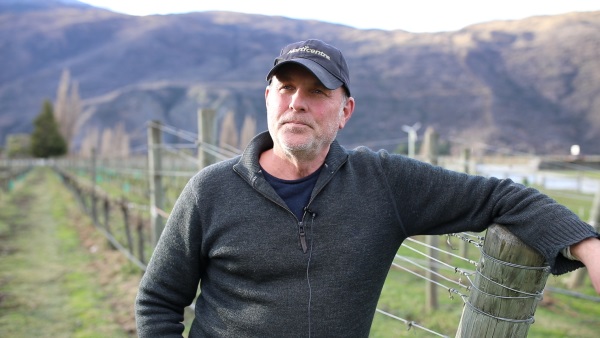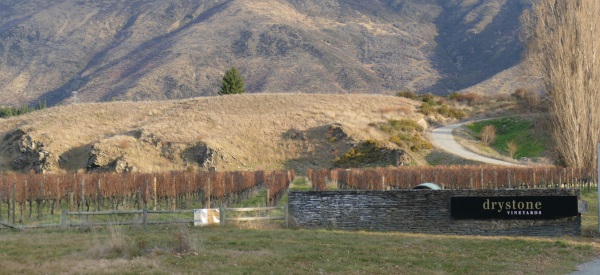Gibbston viticulturist claims local industry may collapse due to ‘abandoned’ vineyard
Fury is fermenting among Queenstown’s Gibbston vineyard owners and viticulturists who claim one landowner’s inaction could undermine the entire local wine industry.
Gary Crabbe, a viticulturist in the area since 1999, alleges the former Anthem vineyard — renamed Drystone — has been ‘‘abandoned’’ by property developer owner Tim Edney.
As a result, airborne powdery mildew has taken hold of the vines planted across the 50-odd hectare vineyard, and because it’s not being treated, the destructive fungi’s spreading like wildfire through neighbouring vineyards within a kilometre.
Crabbe claims Edney, who bought the vineyard from Dave Henderson, has ‘‘abdicated all responsibility’’ relating to maintenance of the vines.
That, he says, has the potential to bankrupt neighbouring vineyards.
But Edney tells Mountain Scene he wasn’t aware of the issues with the airborne powdery mildew and promises to investigate further.
Scene understands there was some helicopter work done on the vineyard last year, in conjunction with a private partner linked to Edney, to spray the vines.
That mitigated the impacts, to a degree, but the powdery mildew, which must be treated regularly, started to make its presence felt at the end of last season, and it’s getting worse.
Edney: ‘‘I thought because last year what we did solved the problem, I just thought that it had all gone quiet.
“I didn’t realise.’’
Crabbe’s concerned the rich-lister is trying to ‘‘force our hand to take care of his land for him’’.
‘‘I went to the [national industry body] New Zealand Winegrowers and talked to their legal team,’’ he says.
‘‘They suggested we go in and spray his vineyard for him and he pays for it.
‘‘I would estimate the bill is over $100,000, as a collective … It wouldn’t solve the problem, but it would prevent it from being
catastrophic.’’
NZ Winegrowers couldn’t respond by deadline yesterday.
Crabbe says the spores survive through winter and warns, unless treated, a ‘‘trainwreck’’ is on its way.
‘‘Come this spring and summer, I’m going to get devastated and owners are going to start screaming at me saying, ‘we’re getting no crop’ and, economically, some of these vineyards might go bankrupt.’’
He’s looking after 16 vineyards in Gibbston, of which six are already affected.

‘‘That’s just the start of it.
‘‘If it starts to blow downwind and becomes established in other vineyards, then that vineyard has a knock-on effect next year … I just know it’s going to be an absolute destruction of this valley.
‘‘People’s livelihoods are based on it, and I’m one of them.
‘‘There are tasting rooms, vineyards and brands that will be severely impacted.’’
Powdery mildew ‘worst billboard’ for wine tourism
Kinross co-owner John Erkkila says dealing with Drystone’s powdery mildew’s already cost them ‘‘hundreds of thousands of dollars’’.
‘‘We got away with it last year, but the year before we lost a whole stack of grapes because of it and then the amount of cost in spraying and everything to deal with it … it’s just an outrage.
‘‘As soon as it comes in, once it gets hold, you lose all your production.’’
It’s also putting a ‘‘massive strain’’ on Kinross’ conversion to organic, he says.
Another viticulturist, whom Scene agreed not to name, alleges parts of the Drystone vineyard have been left to go to rack and ruin and have become an ‘‘infection block’’ for the rest of Gibbston, in part due to the La Nina weather pattern over the past three years.
‘‘There’s been no traditional wind patterns, [the spores have] been going everywhere and everyone’s been affected by it.’’
He says the matter is dire and has wide-reaching implications.
‘‘That is the worst billboard for our wine tourism that you could imagine … it’s not the billboard that we need, visually, and … it’s
actually affecting the ability to farm and causing costs for vineyards outside of that fence line.’’
He believes Otago Regional Council (ORC) should step in, giving Edney’s affecting his neighbours’ ability to farm.
But Crabbe says he got the bum’s rush from ORC when he lodged a complaint through the pollution hotline.
ORC environmental implementation manager Libby Caldwell says while there’s been no recent report lodged with them about powdery mildew, Scene’s media inquiry has been sent to Ministry for Primary Industries (MPI).
‘‘There is no action for ORC at this point until MPI undertake any investigation,’’ she says.
But MPI says it’s not on biosecurity’s radar and believes if the fungi is putting other vineyards at risk, it’s a matter for the regional council, or NZ Winegrowers.
As far as the anonymous viticulturist’s concerned, the best thing Edney could do now is mothball Drystone.
‘‘Spend the money to farm it so you’re not infecting someone else … [and] affecting someone else’s outcome.’’




